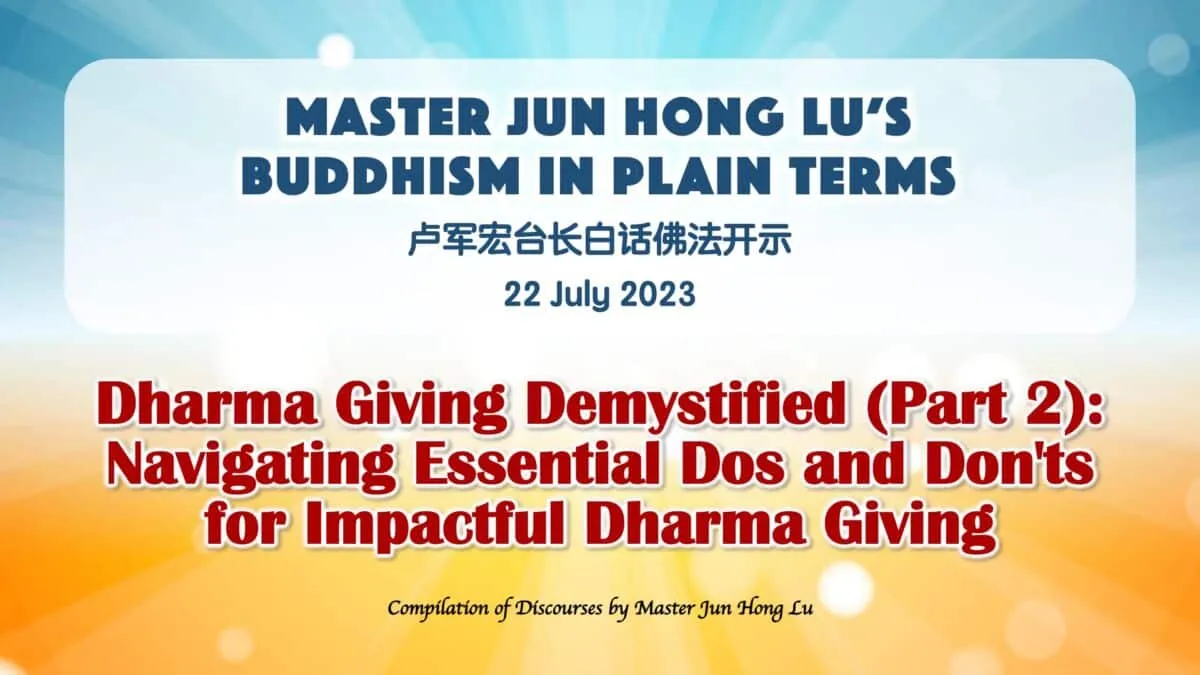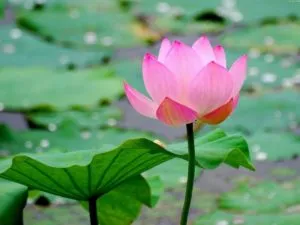Curious to explore the dos and don’ts of dharma giving?
Want to ensure your dharma giving creates a ripple effect that touches lives?
This comprehensive guide will provide you with the
essential knowledge and practical tips
to maximise the impact of your dharma giving.
< Faith Is The Key To All Merits And Virtues 一切功德来自于信 >
SOURCE & CITATION

IT IS BEST TO CITE THE SOURCE WHEN SHARING MASTER’S DISCOURSES
Caller: A fellow Buddhist practitioner used to come across a statement on blogs that says, “Secretariat, please verify whether this is a discourse from Master”.
Seeing this, the Buddhist practitioner thought he should indicate the source when sharing Master’s discourses in the future in order to avoid creating confusion among other Buddhist practitioners. But, in reality he does not do so because he finds it troublesome.
He subsequently dreamt of Master and in the dream, Master asked him sternly, “Why didn’t you insert the source?”.
With regards to this matter, I’d like to ask Master whether it’s best to insert the source before circulating those relevant discourses of Master as means to minimise doubts among other Buddhist practitioners and to facilitate online searches?
Master Jun Hong Lu: It’s best if you can do so because it will help boost the confidence of others once they are assured that the discourse is from me. Otherwise, they won’t believe in what you post.
Caller: Alright.
Source: Wenda20200830 33:13, Master Jun Hong Lu’s call-in radio program
IS IT APPROPRIATE TO PIECE TOGETHER MASTER’S TEACHINGS FROM DIFFERENT PARTS OF A DISCOURSE?

Caller: There are fellow Buddhist practitioners who will extract Master’s discourses or Buddhism in Plain Terms quotes that they consider timeless. When they go about doing so, they will pluck a phrase or a few words from a paragraph or the ensuing paragraphs and stitch them together to create the impression that it is one whole paragraph and tag it as ‘Master Lu’s discourse’. There are times when the essence of the teachings may somewhat be altered as a result. Is it appropriate to do so, Master?
Master Jun Hong Lu: You cannot change the words uttered by Bodhisattvas and make them into yours. Assuming I’m conducting a class today, I cannot claim the teachings of the Buddha to be mine. Similarly, you should not change my words and make them your own. There should be a clear distinction.
Caller: Sometimes, they may even stitch together sentences from different paragraphs as long as these sentences appear to be timeless quotes.
Master Jun Hong Lu: That’s fine. There is nothing wrong with it.
Caller: But, they run the risk of having the messages being misinterpreted, which would not be ideal, would it?
Master Jun Hong Lu: Indeed it is considered as ‘quoting things out of context’ (断章取义) to a certain extent and that’s not good. This is because the points I make in Buddhism in Plain Terms are context specific and here you are making a generalisation to other contexts. In this case, you are surely at fault.
Source: Wenda20180225A 07:41, Master Jun Hong Lu’s call-in radio program
THE CHOICE OF IMAGES
DO NOT USE IMAGES OF BODHISATTVA IN GRAPHICS FOR WORDS OF WISDOM AS IT IS DISRESPECTFUL
Caller: In some social media groups, some Buddhist friends are very earnest and have designed many graphics for Master’s Words of Wisdom or notices on activities.
Oftentimes, their graphics have images of Bodhisattva. When we click on the graphics, we will inadvertently touch on the Bodhisattva’s head, face, and etc. In this regard, is it suitable to use images of Bodhisattva for such graphics? Is it even in accordance with the dharma and the path of rightness?
Master Jun Hong Lu: You may design with images of lotus, but avoid using the portrait of Bodhisattva. Why do you have to use the image of Bodhisattva? It’s improper and disrespectful to Bodhisattva. Haven’t I mentioned this before? The same goes to the cup that has imprints of the Great Compassion Mantra, because the moment you hold the cup, you are literally squeezing the names of the Bodhisattvas.
Source: Wenda20190419 22:17, Master Jun Hong Lu’s call-in radio program
IMAGES OF BUDDHAS AND BODHISATTVAS USED FOR ONLINE DHARMA SHARING SHOULD HAVE A SOLEMN APPEARANCE
Question: In their effort to propagate the dharma online, some Buddhist practitioners will modify the images or appearances of Amitabha and Guan Yin Bodhisattva to be human-like. Is this appropriate?
Answer: Such actions are disrespectful and sacrilegious towards the Bodhisattvas (亵渎菩萨), and they are inviting trouble. The Dharma Protectors will surely punish those involved. If the person asking this question finds this matter amusing, he is bound to shoulder the negative karma of it (背业), and will be punished by the Dharma Protectors. As important as it is for all of you to respect and revere my teachings, being your Master, how dare you not honour the Bodhisattvas?
Source: Master Jun Hong Lu’s Discourse (Question 377), 19 April 2020
MINDFUL USE OF VISUALS IN DHARMA GIVING
Question: Should we avoid using photos of real individuals, including those of novices, monks and nuns, in all dharma materials?
Answer: It is advisable to avoid using such visuals.
Source: Master Jun Hong Lu’s Discourse (Question 379), 27 April 2020
IT IS NOT ADVISABLE TO USE GRAPHICS THAT EVOKE FANTASIES
Question: In an effort to spread the dharma, some fellow practitioners will match Master’s teachings with a caricature of a beautiful girl. Is this appropriate?
Answer: It’s never ideal to use anything that evokes fantasies (任何让人产生臆想的东西都不好). This explains why you should always go for a decent appearance because the moment you overstep the bounds and make others’ imagination run wild, you have sinned (你就有罪了).
Source: Master Jun Hong Lu’s Discourse (Question 379), 27 April 2020
IT IS NOT ADVISABLE TO USE ONE’S PORTRAIT AS PROFILE PICTURE ON SOCIAL NETWORK

Question: Master has advised against using the landscape painting meant for the Buddhist altar as computer wallpaper, because of the risk of unwholesome content in the computer. What about using a picture of us standing before the landscape portrait as a profile picture on WeChat (an instant messaging app)?
Answer: That should not be a problem, however, it is best not to use your own portrait. Instead, use a background picture like the scenery shots in the film, in which there is no one in there, except landscape or flowers. Using your own face as the profile picture may spell trouble because you run the risk of being cast a spell on (下降头).
Source: Master Jun Hong Lu’s World Buddhist Fellowship Meeting, Kuala Lumpur, Malaysia, 28 December 2018
Q: Is there a specific timing to observe for dharma giving?

THERE IS NO NEED TO OBSERVE TIME-GAP BETWEEN POSTINGS OF DHARMA TEACHINGS ONLINE
Caller: A fellow practitioner dreamt of Bodhisattva reminding him, “Do not send dharma teachings consecutively on social media. Leave some buffer time so that other practitioners get to read them online”. Master, could you advise as to how we should pace our postings?
Master Jun Hong Lu: That’s not true. Don’t listen to what he says. He is as if advising you to take intermittent breaks in your effort to be a good person. There’s no such thing. You must be joking! To be a good person, basically you must be relentless in performing kind deeds. Do you think the Buddha even took breaks in between His dharma-propagation quest? There were no such breaks.
Caller: Master, come to think of it such messages should first be verified by 2OR Secretariat before broadcasting them. In fact, such messages should not be disseminated at will because they can be misleading.
Master Jun Hong Lu: He has already misled others and created karmic obstacles for himself. This is why I want to organise a coaching class for everyone. There are too many ignorant people who senselessly go about disseminating messages that they barely understand anything about, only to trigger an eruption of karmic obstacles. Even so, they may still be in the dark when something untowards befalls their loved ones or when illness strikes them.
Many people lament, “Having performed so many meritorious deeds, why is it that luck is never on my side?”. They are clearly oblivious to the source of their misfortunes – reckless speech. Does it make sense at all to encourage others to take intermittent breaks from their dharma propagation quest (弘法哪有叫人家停停歇歇的)? You must be kidding!
Source: Wenda20161016A 25:58, Master Jun Hong Lu’s call-in radio program
EXERCISE DISCRETION WHEN SHARING THE DHARMA AT NIGHT

Caller: Some Buddhist practitioners are still eagerly sharing depictions of Journey to Heaven that illustrate scenes in the underworld even though it is past 10pm. In the view of certain Buddhist practitioners, such sharing would invite considerable amount of Yin (negative) energy, but they are afraid of reminding the senders out of concern of bringing karmic obstacles upon themselves because it may be viewed as deterring others from sharing the dharma. In this respect, I’d like to ask Master, in posting dharma teachings online, should we take into consideration factors like the timing and content?
Master Jun Hong Lu: Of course! You must think of the effectiveness of your sharing. How could you only focus on sharing the dharma but not consider the outcome of your effort? What’s the point if your postings fail to create a positive effect?
Caller: Are there karmic obstacles if such postings make others feel annoyed or negatively impacted?
Master Jun Hong Lu: Yes. Let me ask you, if a doctor only cares about writing a prescription and has no regard whatsoever about the well-being of his patients, will this doctor shoulder the corresponding karmic obstacles?
Caller: Yes. It has been brought up by some fellow practitioners that Master has advised against hindering others from sharing the dharma and in light of this, no one dares to express their views.
Master Jun Hong Lu: When you express your opinion in this case, your intention is not to obstruct his dharma propagation effort. Instead, it is to make his sharing more impactful, right?
Caller: Yes. After reading the Journey to Heaven, some people feel scared, while others manage to deepen their belief in the law of cause and effect. Why is it that some people are frightened by it? Is it even suitable to share such content during nighttime?
Master Jun Hong Lu: Not everyone will want to read such content at night. However, it is best to share depictions of journeys to heaven rather than journeys to the underworld at night. Exercise discretion in your selection for sharing. After all, nighttime is often associated with fear and Yin energy, so it is important that you customise your sharing accordingly.
Source: Wenda20200410 12:30, Master Jun Hong Lu’s call-in radio program
< Unleash the Dormant Potential to Surpass Yourself >
< Buddhism in Plain Terms < 白话佛法共修分享


